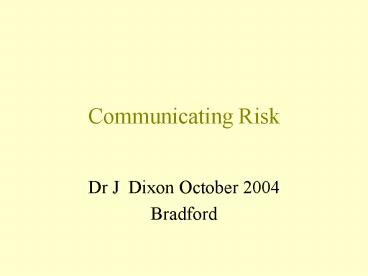Communicating Risk - PowerPoint PPT Presentation
1 / 11
Title:
Communicating Risk
Description:
87 yr old, new onset Atrial Fibrillation, history of IHD, hypertension, and ... between short term and long term consequences (shoulder cortisone injection) ... – PowerPoint PPT presentation
Number of Views:93
Avg rating:3.0/5.0
Title: Communicating Risk
1
Communicating Risk
- Dr J Dixon October 2004
- Bradford
2
Example
- 87 yr old, new onset Atrial Fibrillation, history
of IHD, hypertension, and previous history of
peptic ulcer disease and acute GI haemorrhage. - Evidence suggests should be anti-coagulated, but
clearly risks with this, and aspirin probably
CId. Hx of falls would probably mitigate against
starting either, but there are clear survival
advantages to cardioversion (5 cva per year) - What does the patient think???
3
Communicating Risk
- Why is this important?
- Enhances concordance with chosen treatment
- Shares responsibility and reduces reliance on GP
- Allows for greater honesty and ultimately reduces
complaints / litigation.
4
Challenges to communicating risk
- Knowing the risks
- Knowing how much to communicate
- Knowing how best to communicate them
5
When should we carefully communicate risk?
- When outcomes differ dramatically between
different choices of treatment both in terms of
severity and likelihood (medical or surgical Rx
for BPH) - Choices involve tradeoffs between short term and
long term consequences (shoulder cortisone
injection) - One choice involves a grave outcome even if
probability is low (aspirin in under 14s for
suspected Kawasakis) - The patient is particularly risk averse (pregnant
mum, severe migraine.) - Certain outcomes have great importance for this
patient (stopping antiepileptic medication in a
fit free milkman)
6
3 patient types
- Deferrers simply defer to their doctor and accept
whatever the doctor feels is best for them - Delayers will prolong the decision making briefly
until they hit upon a decision strategy or rule
of thumb and grasp the decision - Deliberators carefully appraise all of the given
information, including the doctors preferred
option and take time before making up their minds.
7
Doctor factors that block effective risk
communication
- We dont know all the facts
- We dont know the risks or their likelihood
- We have hidden agendas- reduction of costs,
prescribing or referral targets - We assume patients dont want to know on basis of
age, ethnicity , perceived intelligence - It undermines our authority
- We have no time, or there is too much information
- This person would never complain
- Influencing the patient into taking the easiest
option (doing nothing?) - Weve always done it this way
8
Patient factors that block effective risk
communication
- Hypochondrias
- Information overload
- Seeking compensation
- Intimidation by perceived unequal relationship
with health professionals - Cultural, ethnic, sexual differences
9
Suggested framework for discussion of risk
- Appreciate interpersonal dynamics and help people
move on- i.e. dont let emotions or experiences
dominate the discussion- reach to understand
patients prejudices then separate the people from
the problems - Consider every option minimising judgement
- Agree on criteria and principles on which to
judge each option- if an impasse occurs- discuss
which criteria takes precedence
10
Decision aids
- Care! Need to be well presented and carefully
explained. - Research shows that they dont actually improve
patient satisfaction at outcome of a discussion. - They can improve knowledge (both GP and patient)
and involvement- e.g. PSA testing (most decline
routine testing when situation fully explained)
11
When it all goes wrong- adverse outcomes
- Document everything including risk communication
discussions - If time permits- approach trainer/MDU to ask how
to approach situation BUT - Without delay seek out patient/family and face
problem openly and honestly- delay suggests cover
ups- - Ask patient about what setting they would like
this to take place in- preserve dignity - Set the stage (you will remember the discussion
we had about risks of X) - Explain what went wrong
- Explain new management plan /options































